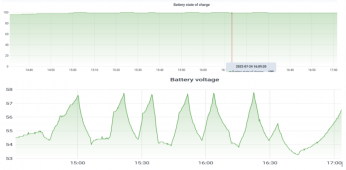A conundrum was brought forth when I asked the forum what might cause a Growatt spfxxxxt to fail starting pv production in the early morning sun. One of several replies; @Zwy posted it could be a possible issue with bulk/float settings, which in a roundabout way, brought us to pre-programmed charge settings when allowing an AIO and battery to determine their own state of affairs.
To be upfront, the ability of the Growatt AIO and eg4 batteries to communicate was one of the features I felt added value to the package. Plug and play. Everybody is talking with each other and happy. Then I posted some charts from Solar Assistant, like the small zoomed clip below. The battery is hoovering around an indicated 99%-100% charge. Yippie, full charge, right, well ... see the voltage?

At first I thought this was the funky bms doing its balancing act that some have posted about, but after some discussion @robby reasons it is the AIO charging up to the very limit of the battery's ability, the bms halting charge, the battery settling, and the process repeating. Keep in mind, when selecting the Li setting in the Growatt AIO and letting the AIO and eg4 batteries do their communication thing, the charge settings are not adjustable. These are factory settings and 57+v is pretty far up the LiFePo4 knees.
So ...
I assume these settings are approved by both Growatt and eg4. Are they?
Why are these charge settings so high? Doesn't this stress the cells possibly shortening their life?
Like me, how many people out there have these components communicating, doing their own thing, expecting the advertised 7000 cycles since everything is 'factory', when in reality we are pushing the upper edge, and possibly shortening the life of our expensive components?
Thoughts ...
To be upfront, the ability of the Growatt AIO and eg4 batteries to communicate was one of the features I felt added value to the package. Plug and play. Everybody is talking with each other and happy. Then I posted some charts from Solar Assistant, like the small zoomed clip below. The battery is hoovering around an indicated 99%-100% charge. Yippie, full charge, right, well ... see the voltage?

At first I thought this was the funky bms doing its balancing act that some have posted about, but after some discussion @robby reasons it is the AIO charging up to the very limit of the battery's ability, the bms halting charge, the battery settling, and the process repeating. Keep in mind, when selecting the Li setting in the Growatt AIO and letting the AIO and eg4 batteries do their communication thing, the charge settings are not adjustable. These are factory settings and 57+v is pretty far up the LiFePo4 knees.
So ...
I assume these settings are approved by both Growatt and eg4. Are they?
Why are these charge settings so high? Doesn't this stress the cells possibly shortening their life?
Like me, how many people out there have these components communicating, doing their own thing, expecting the advertised 7000 cycles since everything is 'factory', when in reality we are pushing the upper edge, and possibly shortening the life of our expensive components?
Thoughts ...



